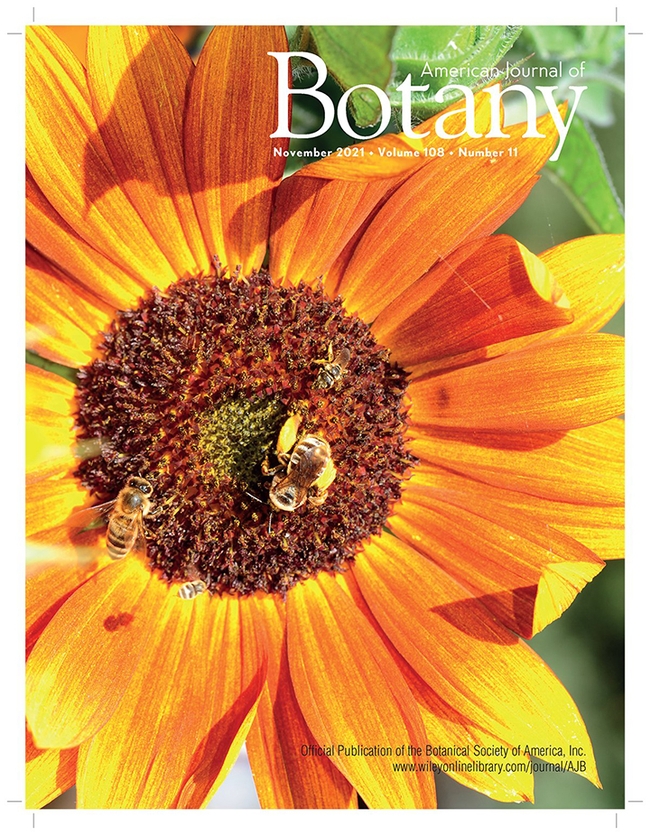- Author: Kathy Keatley Garvey
There's a way for a bear to outsmart a fox.
A teddy bear bee, that is.
We just witnessed a male Valley carpenter bee, Xylocopa sonorina, aka "the teddy bear bee," buzz up to a patch of foxgloves, Digitalis purpurea.
Then he engaged in the foraging behavior known as nectar-robbing. That's when a carpenter bee or bumble bee drills a hole at the base of the corolla--or finds a hole already drilled--and "robs" the nectar, bypassing the flower's reproductive parts that lead to pollination.
Hey, I'm not going through the front door! I'm not! I'm taking the back door.
We usually see female Valley carpenter bees drilling the holes and robbing the nectar. This time, though, it was a male. The late Robbin Thorp, UC Davis distinguished emeritus professor of entomology, always referred to the males as "teddy bear bees," adding "boy bees don't sting."
This particular teddy bear lingered a bit, sipped some nectar, and then took flight.
That's how a "bear" outsmarts a fox.
By the way, sexual dimorphism is pronounced in X. sonorina. The male is a green-eyed blond, while the females are solid black.
In our garden, other plants popular for nectar robbing include the salvias, ‘Hot Lips' Sage (Salvia ‘Hot Lips'), and California fuchsia (Epilobium canum). Sometimes you'll see a honey bee following a carpenter bee or bumble bee around to gain easy access to the nectar. She "knows the drill."
Scientists have known about nectar-robbing for more than two centuries. German naturalist Christian Konrad Sprengel observed bumble bees perforating the corollas of flowers as early as 1793, according to Wikipedia. Sprengel recorded this phenomenon in his book, The Secret of Nature in the Form and Fertilization of Flowers Discovered. Charles Darwin observed nectar robbing (by bumble bees) in 1859 and published his observations in his book The Origin of Species.
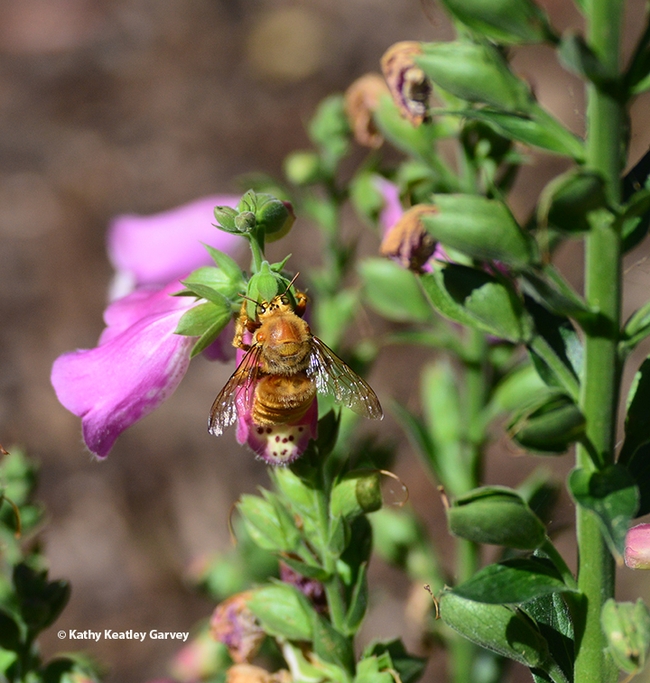
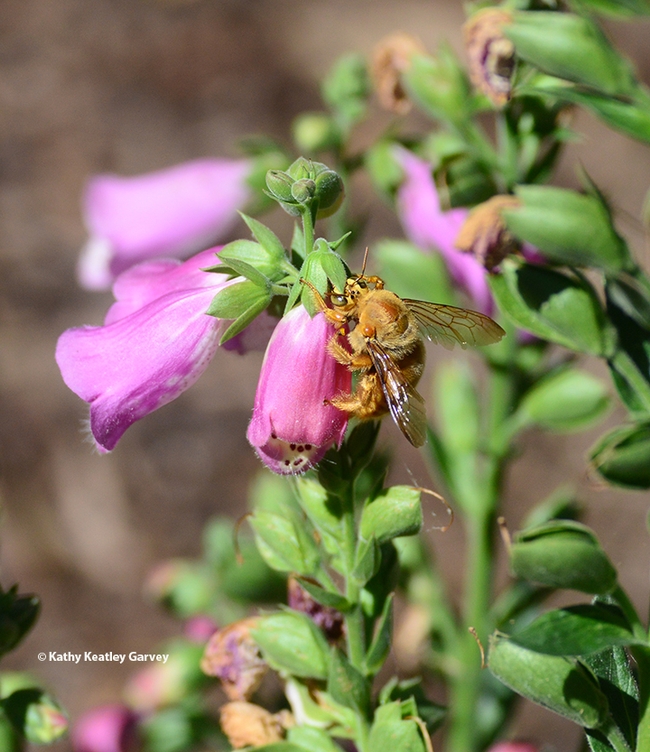
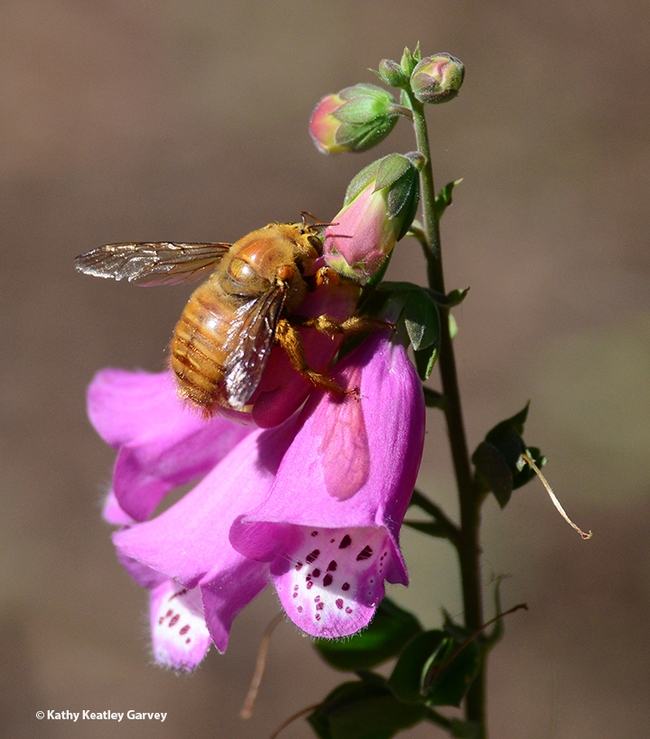
- Author: Kathy Keatley Garvey
When you sit down to share a meal with family and friends, you might not be thinking the pests that want their share.
But you should.
And if you attend the Bohart Museum of Entomology open house from 1 to 4 p.m., Saturday, May 28 in Room 1124 of the Academic Surge Building, Crocker Lane, UC Davis campus, you can learn more about them.
The event, free and open to the public, is themed “Bugs in Ag: What Is Eating Our Crops and What Is Eating Them?”
Cooperative Extension specialist Ian Grettenberger, a member of the UC Davis Department of Entomology faculty, will discuss pests of rice and alfalfa and other agricultural crops, and also will cover such beneficial insects as lady beetles, aka ladybugs. He and his postdoctoral fellow Buddhi Achhami will field questions.
Grettenberger plans to feature a few videos of the pests and their natural enemies and display live insects from alfalfa crops, as well as tadpole shrimp. “We plan to talk broadly about the pests that eat our crops and the natural enemies that help protect them,” Grettenberger said.
The family arts and crafts activity will be making tadpole shrimp hats for folks to take home.
Meanwhile, you've probably seen lady beetles, aka ladybugs, devouring aphids, and maybe an assassin bug spearing an insect.
You'll learn more about them at the Bohart open house. It's the home of a worldwide collection of eight million insect specimens. It also has a live "petting zoo," comprised of Madagascar hissing cockroaches, stick insects and tarantulas, and an insect-themed gift shop.
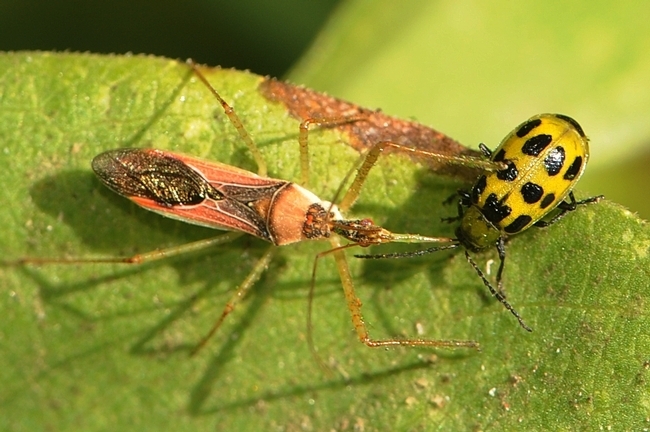

- Author: Kathy Keatley Garvey
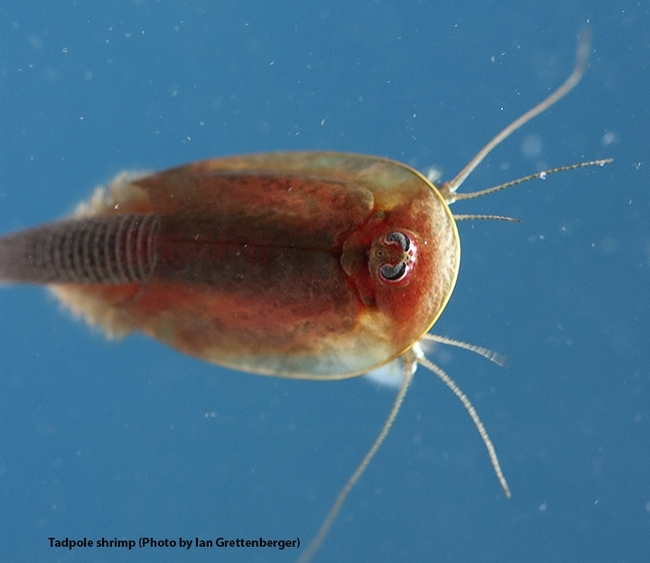
First, they're neither tadpoles nor shrimp. Second, they're crustaceans and are pests of rice.
Tadpole shrimp will be one of the topics that Cooperative Extension specialist Ian Grettenberger, an agricultural entomologist, will cover when the Bohart Museum of Entomology hosts a family friendly open house from 1 to 4 p.m., Saturday, May 28 in Room 1124 of the Academic Surge Building, Crocker Lane, UC Davis campus.
The event, free and open to the public, is themed “Bugs in Ag: What Is Eating Our Crops and What Is Eating Them?”
Grettenberger, a member of the UC Davis Department of Entomology faculty, will discuss pests of rice and alfalfa and other agricultural crops, and also will cover such beneficial insects as lady beetles, aka lady bugs.
But back to tadpole shrimp. We asked Grettenberger 10 facts that most people may not know about these critters. Here we go!
- The common name for Triops species is tadpole shrimp because they look superficially like tadpoles (frogs), but another common name is shield shrimp, named after their shield-like carapace.
- The genus name for tadpole shrimp, "Triops" comes from Latin "tri" (three) and Greek "?ps" (eye). They have two large compound eyes and a third simple eye (ocellus) used for detecting light.
- The California crop where tadpole shrimp are relevant is rice. Triops longicaudatus is an early-season pest that can damage germinating seeds.
- While the pest species Triops longicaudatus is an abundant species because it can do well in rice fields, another species in California, Lepidurus packardi (vernal pool tadpole shrimp), is endangered and relies on limited vernal pool habitats for survival.
- Triops longicaudatus carry their eggs in egg sacs, where they are kept before being deposited.
- Eggs of Triops longicaudatus typically dry out completely as rice fields are drained or pools dry. Eggs can survive for many years (10's of years) in a desiccated state, able to hatch when they are flooded again.
- Triops longicaudatus are omnivorous, meaning they eat plant material, invertebrates, and even their siblings (cannibalism!).
- Triops longicaudatus will eat mosquito larvae.
- A possible sign of a rice field full of tadpole shrimp is very murky water; as they feed and burrow on the bottom, they stir up mud and muddy the water.
- You can actually buy dried eggs of Triops longicaudatus and keep them as a pet.

“We plan to talk broadly about the pests that eat our crops and the natural enemies that help protect them,” Grettenberger said. He and postdoctoral fellow Buddhi Achhami of the Grettenberger lab will field questions. (For more information on tadpole shrimp, be sure to access KQED's Deep Look video, Tadpole Shrimp Are Coming For Your Rice. which includes Grettenberger's expertise; and the UC Statewide Integrated Pest Management Program's information about tadpole shrimp.)
Also during the Bohart Museum open house, the family activity is to make tadpole shrimp hats or puppets. "Googly eyes" will be used to imitate the compound eyes and and the ocellus, said Tabatha Yang, the Bohart Museum education and outreach coordinator.
The Bohart Museum, directed by Lynn Kimsey, UC Davis distinguished professor of entomology, houses a global collection of eight million insect specimens; a live "petting zoo" comprised of Madagascar hissing cockroaches, walking sticks (stick insects) and tarantulas; and a year-around gift shop (also online) stocked with insect-themed gifts, such as t-shirts, hooded sweatshirts, posters, jewelry, books, puppets, candy and collecting equipment.
The Bohart Museum has been closed to the public for the last two years due to COVID-19 pandemic precautions. The Bohart observed UC Davis Picnic Day by setting up displays in the hallway of the Academic Surge Building. This spring the museum is open to the public, but groups must make reservations and everyone must follow the UC Davis visitor guidelines: https://campusready.ucdavis.edu/visitors? The museum's "visiting us" page includes more information.
- Author: Kathy Keatley Garvey
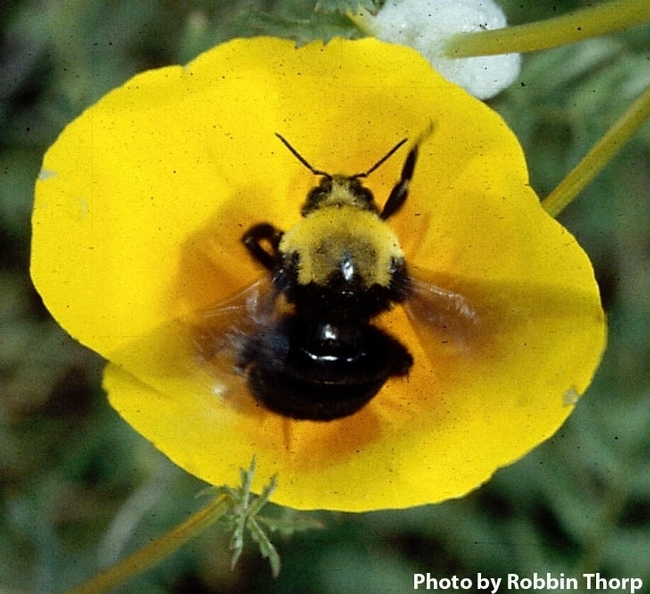
Professor Thorp (1933-2019), a 30-year member of the Department of Entomology and Nematology and a worldwide authority on bees, was a tireless advocate of bumble bee conservation. During his retirement, he co-authored Bumble Bees of North America: An Identification Guide (Princeton University, 2014) and California Bees and Blooms: A Guide for Gardeners and Naturalists (Heyday, 2014).
And every summer from 2002 to 2018, Thorp volunteered his time and expertise to teach at The Bee Course, an annual workshop sponsored by the American Museum of Natural History and held at the Southwestern Research Station, Portal, Ariz.
Thorp also served as the regional co-chair of the Wild Bee Specialist Group of the International Union for Conservation of Nature (IUCN) and sounded the alarm about bumble bee declines, including Franklin's bumble bee, Bombus franklini, found only in its narrow distribution range of southern Oregon and northern California. Thorp last saw it near Mt. Ashland in 2006 and it is is now feared extinct or at the brink of extinction. The bee inhabits--or did--a 13,300-square-mile area confined to five counties--Siskiyou and Trinity counties in California; and Jackson, Douglas and Josephine counties in Oregon.
Enter the California Bumble Bee Atlas (CBBA), a collaboration of the California Department of Fish and Wildlife (CDFW), Sacramento, and the Xerces Society for Invertebrate Conservation, headquartered in Portland, Ore. Launched in March 2022, the Atlas is a "collaborative community science effort to track and conserve the state's native bumble bee species," according to Dylan Winkler, bumble bee scientific aide for the CDFW's Wildlife Diversity Program.
Back in September 2021, the U.S. Fish and Wildlife Service announced that the American bumble bee, "whose populations have plummeted by nearly 90 percent, may warrant Endangered Species Act protection." The announcement kicked off a one-year status assessment of the species. (See news story)
If you're interested in bumble bee conservation, take note. Winkler will lead a "Bumble Bee Walk" from 10 a.m. to noon on Saturday, May 28 in the UC Davis Arboretum and Public Garden. The goal is to teach interested participants how to survey bumble bees. You can pre-register at https://arcg.is/0PDyO4. Organizers plan to cap attendance at 20 people. Details about this Atlas event and several more scheduled in June:
- Saturday, May 28: UC Davis Arboretum, Davis, CA (Yolo County), parking at Putah Creek Lodge Parking Lot, Garrod Drive, Davis, CA 95616. Tour of the native plant gardens and the forest along Putah Creek from 10 a.m. to noon.
- Saturday, June 4: The Gardens at Lake Merritt, 666 Bellevue Avenue, Oakland, CA (Alameda County). Tour of the gardens from 9 a.m. to 11 a.m.
- Sunday, June 5: College of Marin at Kentfield (Marin County), parking at covered Lots 6/7 off College Ave, Kentfield, CA 94904. Details: Meet at bridge over Corte Madera Creek. Tour of the campus native plants from 10 a.m. to noon.
- Saturday, June 18: Soil Born Farms, Rancho Cordova, CA (Sacramento County), parking at Soil Born Farms: American River Ranch, 2140 Chase Drive, Rancho Cordova, CA 95670. As part of National Pollinator Week, the group will tour the gardens from 10 a.m. to noon. Closed-toed shoes required.
Of the 50 species of bumble bees found in North America, an estimated 25 inhabit California. Overall, a quarter is at risk, according to the Atlas website. The decline is attributed to "loss or fragmentation of habitat, pesticide exposure, climate change, overgrazing, competition with honey bees, low genetic diversity, and perhaps most significant of all, the introduction and distribution of pathogens through commercial honey bee and bumble bee colonies used for crop pollination. All of these factors likely interact, increasing pollinator vulnerability. To support bumble bees, it is critical to protect existing habitat while creating and maintaining new habitat."
Winkler says "we will be using butterfly nets to catch bees, then move them to small vials, and chill them in coolers with ice, so we can take ID'able photographs of them before releasing." The full protocol is at https://www.cabumblebeeatlas.org/point-surveys.html
What bumble bees might you see May 28 in the Arboretum? Bombus vosnesenskii, the yellow-faced bumble bee, and B. melanopygus, the black-tailed bumble bee. "There is a record of B. crotchii at the arboretum from last year around the same date, which is rare and would be amazing to see!" Winkler said.
The project is funded by the U.S. Fish and Wildlife Service through the Wildlife and Sport Fish Restoration Fund. Funding is also provided by the Bureau of Land Management and several private foundations. Read more about the project and the list of coordinators here.
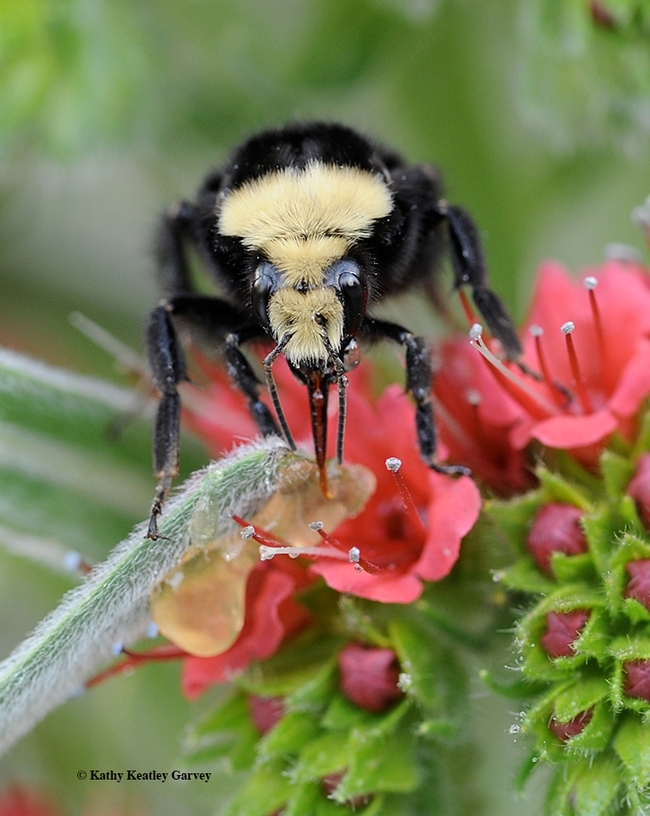
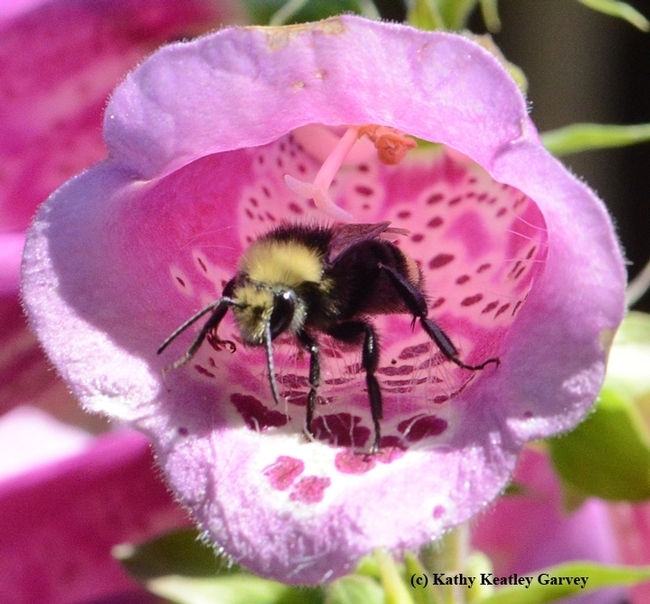
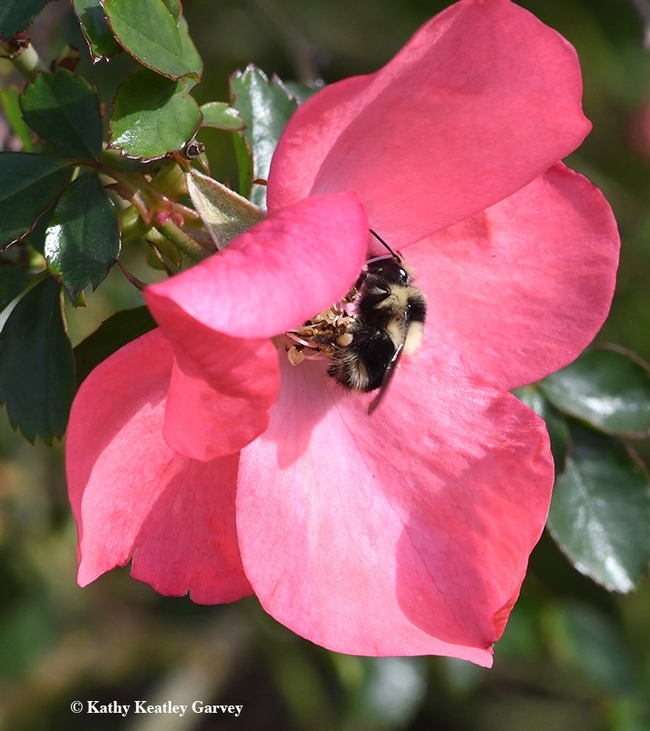
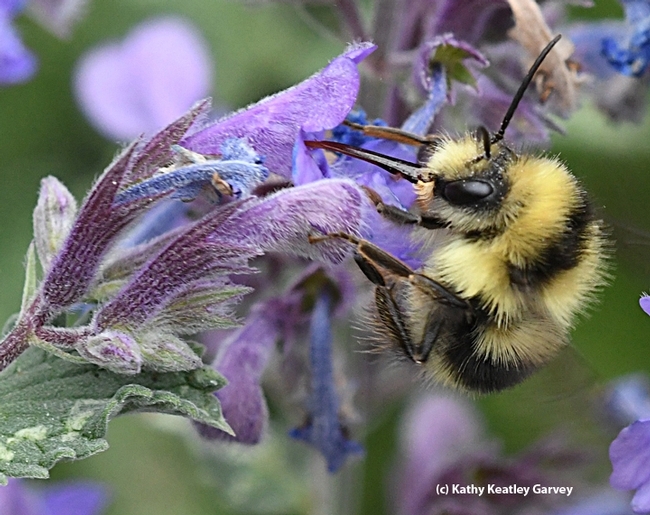
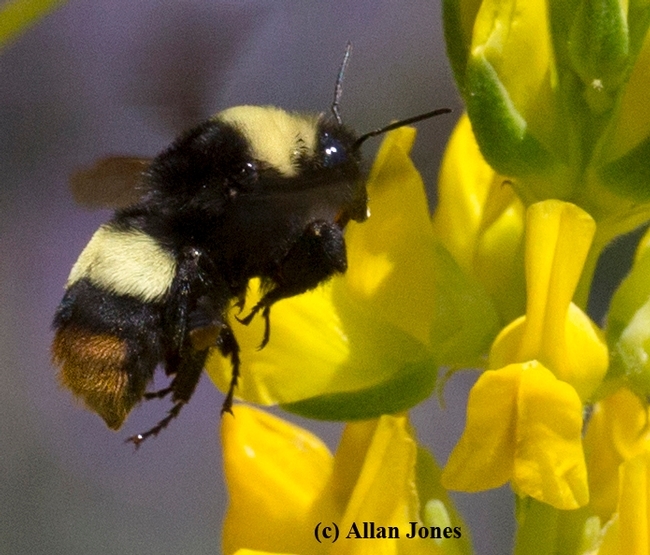
- Author: Kathy Keatley Garvey
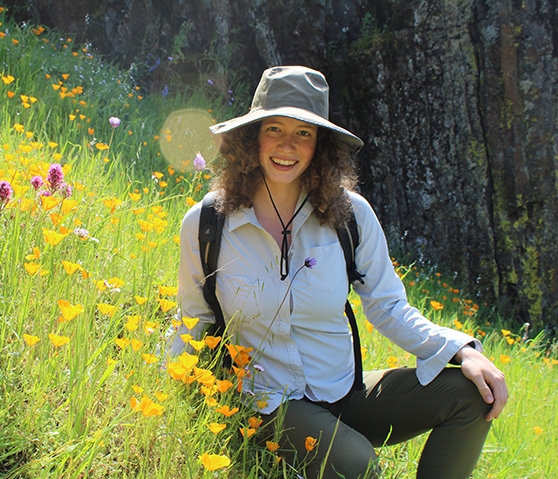
The Zoom link:
https://ucdavis.zoom.us/j/92038151658. (Contact Page at mpage@ucdavis.edu for the ID number and passcode.)
Page studies with major professor and pollination ecologist Neal Williams of the UC Davis Department of Entomology and Nematology. Her work suggests that honey bees reduce pollen and nectar availability in flowers, leading to competitive displacement of native bees.
"Competitive displacement of native bees may in turn decrease plant pollination because native bees are often more effective than native bees as pollinators," Page says. "My research suggests that such changes are already occurring for Camassia quamash (small camas) following honey bee introductions in the Sierra Nevada."
Page is scheduled to receive her doctorate in entomology in June 2022 and then begin a postdoctoral fellowship with assistant professor Scott McArt at Cornell University, where she will investigate patterns of interspecific pathogen transmission and how more sustainable beekeeping practices might mitigate the negative effects of competition. McArt recently delivered a seminar hosted by the UC Davis Department of Entomology and Nematology on "Pesticide Risk to Pollinators: What We Know and What We Need to Know Better."
In July 2019, Page collaborated with colleagues at Cornell and the University of Minnesota to present a workshop on the intersections of science and social justice, aiming to make science more open and accessible.
Page holds a master's degree in entomology (2019) from UC Davis and a bachelor's degree in biology (2016), cum laude, from Scripps College, Claremont, Calif.
Highly recognized for her work, Page received a three-year $115,000 National Defense Science and Engineering Graduate Fellowship, funded by the Department of Defense. She was one of 69 recipients out of more than 3600 applicants. She earlier won a campuswide 2016-17 Graduate Scholars Fellowship of $25,200; a Vansell Scholarship in both 2018 and 2019; and Davis Society Botanical grants in 2017, 2018 and 2019. A 2018 Duffey-Dingle Research Fellowship also helped fund her research (optimizing pollinator plant mixes to simultaneously support wild and managed bees).
Active in the Entomological Society of America and the Ecological Society of America, Page scored a second-place award for her project, "Optimizing Wildflower Plant Mixes to Support Wild and Managed Bees" in a 2021 student competition hosted by the Entomological Society of America. She also presented “Impacts of Honey Bee Introductions on the Pollination of a Sierra Wildflower" at the August 2020 meeting of the Ecological Society of America, and "Can Visitation and Pollen Transport Patterns Predict Plant Pollination?" at the April 2019 meeting of the Pacific Branch, Entomological Society of America.
A strong supporter of community outreach and STEM, Page has been active in leadership activities in the summer program, Girls Outdoor Adventure and Leadership (GOALS) since August 2017. The free program targets underrepresented teens. Page has served as a program co-organizer, mentor and lecturer. She helped organize the 2021 summer program, led a lecture on introductory data analysis, and assisted students with their community science project (identifying pollinators in urban gardens).
Page was also active in Center for Land-Based Learning, serving as a mentor in the Student and Landowner Education and Watershed Stewardship. She mentored high school students, engaging them in hands-on conservation science at Say Hay Farm in Yolo County, and teaching them about how wildflower plantings benefit bees.
Page and postdoctoral researcher Charlie Casey Nicholson of Williams lab co-authored the November 2021 cover story, A Meta-Analysis of Single Visit Pollination Effectiveness Comparing Honeybees and other Floral Visitors, in the American Journal of Botany
